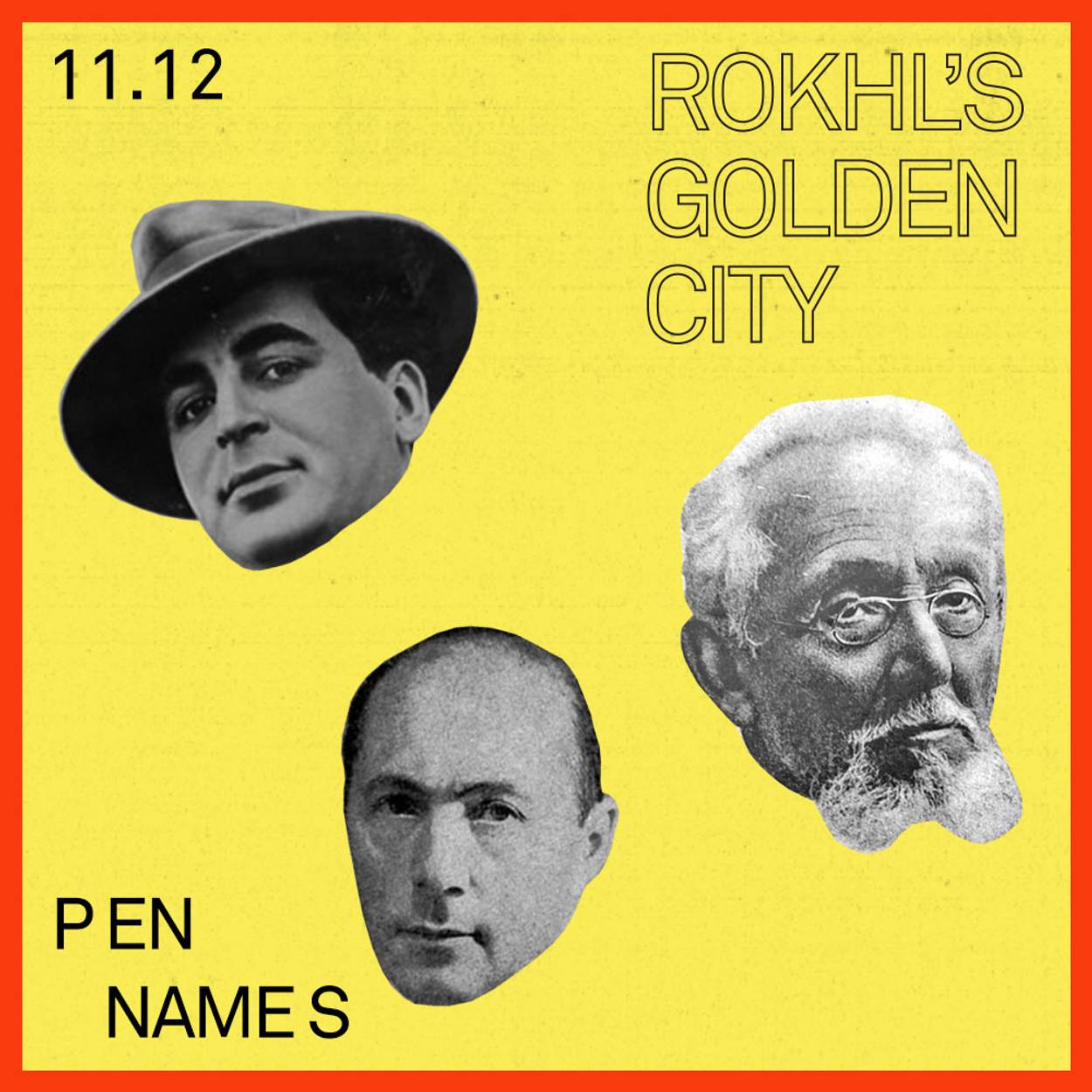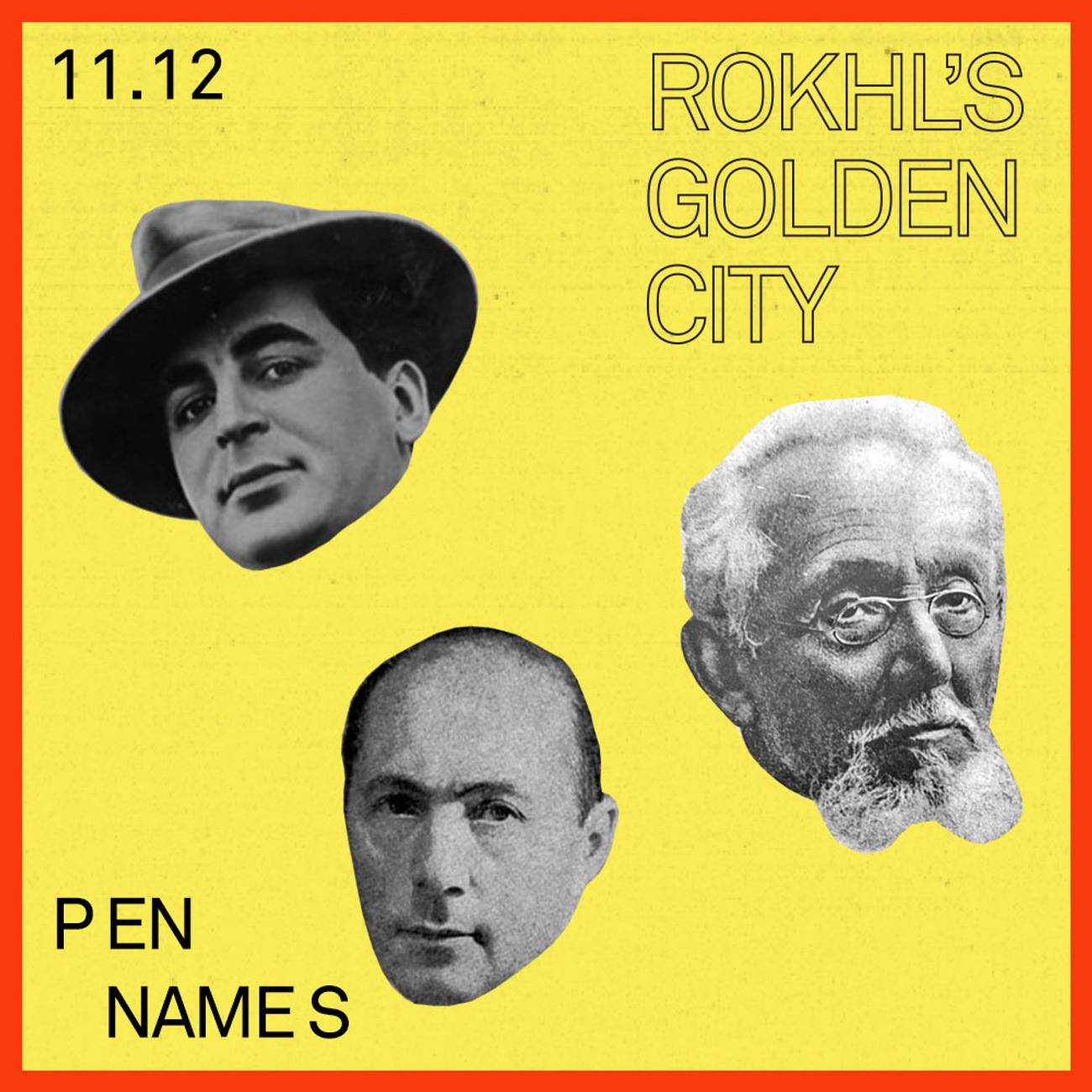What’s in a Name
Rokhl’s Golden City: Inside the world of Yiddish pseudonyms




Jacob wrestled the angel and was given the name Israel. Ralph Lifshitz took the last name “Lauren” and a Jew from the Bronx became an avatar of high WASP aesthetics. Throughout the ages, name changes have been constitutive of Jewish history. This much is obvious.
Of course, not all such name changes are the result of divine favor. In Eastern Europe, many Jews believed the Angel of Death was very powerful, but also very easily fooled. They avoided addressing the ill by name, lest Death be paying attention. A sick baby might be given a new name, such as Alter (old) or Chaim (life) or even Zeyde or Bobe (grandfather or grandmother) as a kind of nominal subterfuge. In A Frog Under the Tongue, historian Marek Tuszewicki lists even more variations on this name-change-for-healing logic. Families might give a sick child the name of a previously deceased sibling, or the first name mentioned in that week’s Torah portion, or even a name associated with a contemporaneous festival.
In all cultures, names are multivalent things, embodying the social, mystical, political, and aesthetic desires of those doing the naming. If you asked me about my own name, Rachael, I might tell you that I’m named for my grandmother Rose (Rokhl), who passed away a few years before I was born. If you asked my parents, they might mention their cat Rachael (same spelling), who passed shortly before my own arrival. (Lucky for me, Nubbins the cat was still alive when they brought me home from the hospital.)
I never loved the name Rachael. I didn’t hate it, but … I didn’t love it. Rachael was lacking the mellifluous promise of Rochelle, or the intrigue of Raquel. As early as sixth grade, I started signing my school papers as R. Kafrissen. Yes, this was perceived as insufferable affectation. No, it didn’t actually save me any time. Nonetheless, I was deeply affirmed, years later, when I saw how common it was for Yiddish writers and other cultural figures to go by a first initial. Lamed Shapiro is a well-known example.
I started taking Yiddish in college, and fairly quickly, Rokhl transitioned from in-class persona to real-life identity. Of course, I liked the name, liked the way it looked and sounded, and I welcomed it as an affirmative marker of my identity as a born-again Yiddishist. But to some degree, taking on Rokhl was a kind of countercultural flex, a rejection of the suburban values I had grown up with. I saw myself as only a semiliterate 22-year-old can: as a member of the revolutionary vanguard, waving my chosen name as banner.
Years later, when I started working as an attorney, I enjoyed having Rokhl as my journalistic nom de plume. No matter how much the law firm demanded of Rachael (and it was a lot), they couldn’t touch Rokhl. But as far as actual anonymity, the two identities weren’t exactly tough to match up. I had always wanted a real pseudonym, an artistic persona that would free up some hidden part of my creative being, and give me license to say what was really on my mind.
A pseudonym would have certainly been keeping with the spirit of modern Yiddish culture. When Sholem Rabinovitch set out to invent a mythology for modern Yiddish literature, and planted the family tree of its yikhes, he did so by speaking as perhaps the most famous invented persona in Yiddish literature: Sholem Aleichem. It was possible to write serious Yiddish literature at that time without a pseudonym, but … it sure did help. As a Russian-identified maskilic intellectual of the time, perhaps Rabinovitch had no choice but to split himself in two in order to find a place from which to speak anew; he made the self-conscious act of choosing Yiddish, a language whose (gendered, maligned) meaning was so overwhelmingly overdetermined
Berl Kagan’s Leksikon fun yidish-shraybers (Lexicon of Yiddish Writers) contains an appendix of some 5,800 pseudonyms. It can seem as if acquiring a pseudonym (or three) was practically a rite of passage for Yiddish writers, especially those writing for the Yiddish press. Those literary pseudonyms range from innocuous to outrageous. Some of my favorites are Bal Makhshoves (Man of Thoughts) for Yisroel Eliashev, Chaver Paver (an idiomatic phrase meaning “bosom friend”) for Gershon Einbinder, and Der Nister (the Hidden One) for Pinhas Kahanovitch.
One of my favorite pseudonymous writers is the Yung Vilne literary group’s Leyzer Wolf. No, not that Leyzer Wolf. I mean Leyzer Mekler (born in a Vilne suburb in 1910). In an article about Yung Vilne, Justin Cammy tells the story of this young Vilne poet “who set out to break the world record for poetry writing. By the end of the month, he had composed 1,001 untitled poems at a rate of more than 30 a day.” It may have been a publicity stunt, but it had style, and it put Leyzer Wolf on the literary map. His poems were at times “whimsical,” “grotesque,” and political, but most importantly, they were accessible. With lines like “The night is white as a banana/the shadows are sweet as tarts,” Leyzer Wolf was an audience favorite.
Though he took his pseudonym from the Sholem Aleichem butcher of the same name, Leyzer Wolf (the poet) saw himself as a new generation in rebellion against an old guard. In 1935 he published a reworking of Tevye the Dairyman, but with a father-son conflict at the center. With this shift in family dynamic, writes Cammy, “violence inside the family threatens to bring down one of Yiddish literature’s most beloved heroes once and for all.”
The sheer number and wild variety of pen names in Yiddish literature urges the reader to take the subject of literary personae far more seriously than simply seeking the “real” name of this or that author. (Indeed, there are so many pen names in Yiddishland I could never even begin to take in all of their forms and meanings.) As Dan Miron writes in his landmark study of Sholem Abramovitch (Mendele Moykher Sforim), A Traveler Disguised, “The mere classification of a name like Stendhal or Mark Twain or Sholem Aleichem as a pseudonym is … almost meaningless. Only when the specific artistic uses to which the names were put, the functions they fulfilled, the meanings they acquired in different social and psychological connections …” only then can the designation of “pseudonym” have any usefulness.
Of course, pseudonyms weren’t just for the literati. Plenty of modern Yiddish Jews reinvented themselves via stage names. And those names weren’t any less interesting or revealing than those of the literary world. Jeremiah Lockwood studies the history (and future) of khazones. He told me that many cantors took new names when they performed for non-Jewish audiences, at the opera, for example, or even in vaudeville. “Name changes,” he said, “reflect the polyglossia of modern Jewish life. Jews weren’t satisfied with just code switching, they had to change the very substance of their beings. They’re like Jacob wrestling the angel and receiving a new name. It’s the angel of history now, instead of the angel of the Lord.” Lockwood pointed me to the cantor Pierre Pinchik as a particularly vivid example.
Pinchik was born Pinchas Segal somewhere around 1900 in Russia. He went from the Hasidic yeshiva world to the Kyiv conservatory. After the Revolution, writes Neil Levin, “He was drafted into an artist’s brigade of the new Red Army, where he was asked to write revolutionary communist songs in Yiddish.” Pinchik went on to tour the Soviet Union as a “folk singer,” taking the new name of Pierre Pinchik, and, somewhat incredibly, he became the chief cantor at the Leningrad Choral Synagogue.
Yiddish remained an important part of Pinchik’s life, even as he reinvented himself. He had a great love of Yiddish poetry, setting classic Yiddish poems to music. He was friends with Soviet Yiddish poets such as Itzik Feffer. Much later, after he had immigrated to the United States, he released an album called Two Sides of Pinchik (1962). The cover features two pictures of him, one, in his cantorial garb, the other, in his incarnation as a suave artist of the world. This duality is also reflected in his song choices. One side of the album is liturgical and the other is traditional Yiddish songs.
There’s something intriguing in the Two Sides concept. Though he has changed his name to the continental-sounding “Pierre,” Pinchik is not hiding anything, but rather, he’s putting his various selves into conversation, perhaps even inviting us to imagine many sides to Pierre Pinchik.
I never ended up taking on my own pseudonym, for various reasons. Perhaps part of that can be blamed on my reading A Wizard of Earthsea at an impressionable age, imbibing (perhaps too deeply) the idea that there is a true name out there for each of us and that names contain (dangerous) power. What if I chose the wrong name?
What I love about Pierre Pinchik’s story is the suggestion that a name change is not necessarily an endpoint or an attempt to hide one’s past, but can be a process of self-discovery, and an invitation to dialogue, with the self, and other.
ALSO: Yugntruf will present an online book launch for their new bilingual, Yiddish-English edition of The Clever Little Tailor, by Solomon Simon. Mikhl Yashinsky and Adah Hetko will contribute music and David Forman (grandson of author Solomon Simon) will read excerpts in Yiddish and English. Nov. 14, at 4 p.m. Free and open to the public via Zoom link … On Nov. 17, Rad Yiddish presents a reading circle of poet Rokhl Korn with Dr. Miriam Isaacs. (Readings in Yiddish, discussion in English). Participants must fill out the online form to receive the Zoom link … “Beyond the Almost Promised Land” is a two-part interview with historian Hasia Diner, about her book In the Almost Promised Land: American Jews and Blacks, 1915-1935. Friend of the column Anthony Russell will moderate the discussion. On Nov. 10 and 17. Register at the Workers Circle website ... This year would be the 100th birthday of beloved Yiddish singer-songwriter Arkady Gendler. Celebrate Gendler’s life on Nov. 28 with a concert of his songs. See here for more details … The first International Klezmer Education Symposium will take place Nov. 29-30. Follow their Facebook page for more information … Dec. 12 will be the final event in a four-part interdisciplinary series on Kol Nidre, “Kol Nidre’s Many Spaces: From the Synagogue to the Archive.” Among the presenters on Dec. 12 will be friend of the column Miryem-Khaye Seigel, with “Presentation and Performance: Kol Nidre on the Bima and the Bine.” Register here.
Rokhl Kafrissen is a New York-based cultural critic and playwright.